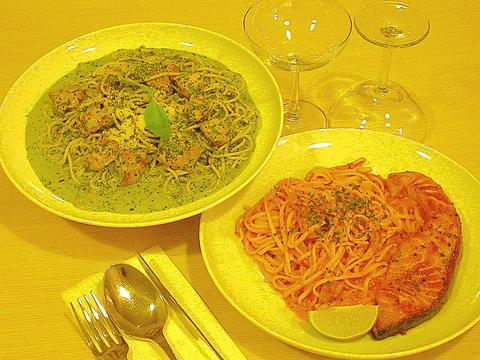The latest addition to Taipei's large pasta market is the pop-art style Nani Nani. Its relaxing atmosphere feels more like a cafe for afternoon tea. In earthy colors, the restaurant's murals depicting children and dogs playing in a park among verdant trees puts you into a cheerful mood, helped also by the small park in front of its door.
The owners of Nani Nani, which opened last month, are not pasta novices. Four years ago, they set up a popular pasta house, Avenue, in a suburban neighborhood -- long before pasta houses became ubiquitous in Taipei. After a one-year break, during which the owners went to China, they've made a comeback. With more space, they have finally been able to carry out the interior design ideas they could not realize before and a new menu that incorporates trendy Japanese flavors.
Nani Nani, meaning "what what" in Japanese, comes from the nickname for the green monster-shaped Rikugo office building by French designer Philippe Starck in Tokyo. Being loyal fans of Starck, the four owners named the restaurant after the building, hoping that diners experience the same amazement at the dishes as Japanese marveling at the curious shape of the building.

PHOTO: VICO LEE, TAIPEI TIMES
The well-traveled owners flew to Tokyo several times to savor the genuine flavors of Japanese-style pastas and came up with over a dozen different items, some of which are rarely found in Taipei. The conventional Italian ones are also on offer. They have also made the best of their advertising background, composing some interesting prose to introduce the dishes.
Being among the first to enter the pasta market, Lily Wu, a co-proprietress, believes that the secret to making good pasta is to eat a lot of it and improve the existing recipes. The top seller at Nani Nani is linguine with roasted chicken and mustard (NT$220). The tender and juicy chicken breast is in bite-sized pieces and is made to taste smoother with the light mustard sauce. Chicken, Wu said, is the house speciality. Linguine with pan-fried salmon and creamy tomato sauce (NT$250) uses uncut steak-size salmon, briefly pan-fried to preserve its firmness.
Spaghetti with lobster (NT$230) is the most Japanese of the pastas. Slightly sweet, the shredded seaweed offsets the baby lobsters. Its "summery" sauce also makes it an ideal choice before Taipei gets into the deep of winter. For those who are more adventurous, spaghetti with squid, capers and gherkins (NT$160) will surprise with its Italian-Japanese flavor, created by the combination of pickled cucumbers, sour beans and garlic. It's pleasantly appetizing, but not as pungent as it sounds. -- vico lee

May 11 to May 18 The original Taichung Railway Station was long thought to have been completely razed. Opening on May 15, 1905, the one-story wooden structure soon outgrew its purpose and was replaced in 1917 by a grandiose, Western-style station. During construction on the third-generation station in 2017, workers discovered the service pit for the original station’s locomotive depot. A year later, a small wooden building on site was determined by historians to be the first stationmaster’s office, built around 1908. With these findings, the Taichung Railway Station Cultural Park now boasts that it has

Wooden houses wedged between concrete, crumbling brick facades with roofs gaping to the sky, and tiled art deco buildings down narrow alleyways: Taichung Central District’s (中區) aging architecture reveals both the allure and reality of the old downtown. From Indigenous settlement to capital under Qing Dynasty rule through to Japanese colonization, Taichung’s Central District holds a long and layered history. The bygone beauty of its streets once earned it the nickname “Little Kyoto.” Since the late eighties, however, the shifting of economic and government centers westward signaled a gradual decline in the area’s evolving fortunes. With the regeneration of the once

The latest Formosa poll released at the end of last month shows confidence in President William Lai (賴清德) plunged 8.1 percent, while satisfaction with the Lai administration fared worse with a drop of 8.5 percent. Those lacking confidence in Lai jumped by 6 percent and dissatisfaction in his administration spiked up 6.7 percent. Confidence in Lai is still strong at 48.6 percent, compared to 43 percent lacking confidence — but this is his worst result overall since he took office. For the first time, dissatisfaction with his administration surpassed satisfaction, 47.3 to 47.1 percent. Though statistically a tie, for most

In February of this year the Taipei Times reported on the visit of Lienchiang County Commissioner Wang Chung-ming (王忠銘) of the Chinese Nationalist Party (KMT) and a delegation to a lantern festival in Fuzhou’s Mawei District in Fujian Province. “Today, Mawei and Matsu jointly marked the lantern festival,” Wang was quoted as saying, adding that both sides “being of one people,” is a cause for joy. Wang was passing around a common claim of officials of the People’s Republic of China (PRC) and the PRC’s allies and supporters in Taiwan — KMT and the Taiwan People’s Party — and elsewhere: Taiwan and